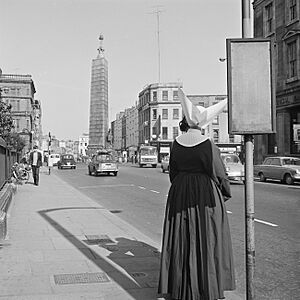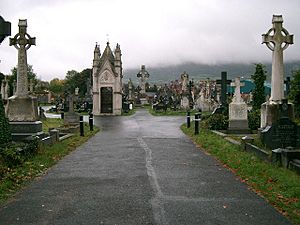Sister Genevieve O'Farrell facts for kids
Sister Genevieve O'Farrell, born Mary O'Farrell, was an inspiring Irish teacher and school leader. She was a nun, part of a group called the Daughters of Charity of Saint Vincent de Paul. For 25 years, from 1963 to 1988, she was the principal of St. Louise's Comprehensive College in Belfast, Northern Ireland. She is best known for making St. Louise's a very successful school for all students and for guiding it through a challenging period known as The Troubles.
Contents
Early Life
Mary O'Farrell was born on March 22, 1923, in Tullamore, Ireland. She was the youngest of five children and the only girl in her family. Her family was very religious, and Mary went to a school run by nuns. Interestingly, when she was young, she didn't like nuns much. She even wrote that their "secretive way of life revolted" her. However, after an experience at school, she felt a strong calling to join a religious order.
Daughters of Charity
In 1941, when she was 18, Mary joined the Daughters of Charity of Saint Vincent de Paul. She believed their mission to help the poor and live among people matched her own desire to make a difference. She started her training in Dublin in 1942.
Mary wasn't initially interested in teaching. However, in 1943, she was sent to a technical school for girls in Manchester, England. There, she was given the name Sister Joseph. She later went to college to become a certified teacher. Her first official job as a nun was at an orphanage school for boys. This is where she was given the name Sister Genevieve. In 1950, she moved to Scotland to work at another orphanage and teach at a primary school for six years.
St. Vincent's Primary School
In 1956, Sister Genevieve was sent to St. Vincent's Primary School in Belfast. At that time, Catholic West Belfast was a very poor area. The school had opened in 1900 to educate girls who worked in linen factories. Sister Vincent Wallace, the head of the school, became a great inspiration to Sister Genevieve. Sister Vincent knew all the families of her students and was very involved in the community. Sister Genevieve learned from her and followed this example throughout her career.
St. Louise's Comprehensive College
<mapframe latitude="54.58671983196476" longitude="-5.966966267326069" zoom="13" width="269" height="175" align="right">{ "type": "FeatureCollection", "features": [ { "type": "Feature", "properties": {}, "geometry": { "type": "Point", "coordinates": [ -5.968902111053468, 54.58651269146787 ] } } ] }</mapframe> St. Louise's Comprehensive College opened on January 8, 1958, with 850 students. It was located near the Falls Road in Belfast. Most of its students came from poor families and had not passed the "11-plus" exam, which meant they couldn't go to grammar schools. Sister Genevieve started as the vice principal. In 1963, she became the principal.
Sister Genevieve believed that every student should leave school with at least one qualification. She encouraged them to get certifications in skills like typing or bookkeeping. She even held practice job interviews to help students find work, especially since unemployment in the area was very high.
She worked hard to make St. Louise's a true comprehensive school. This meant it was a school where students of all different academic abilities could learn and succeed together. Some of her best students went on to top universities, like journalist Mary O'Hara, who studied at Cambridge.
Sister Genevieve deeply cared for her students. If parents needed to take their daughter out of school so she could work, Sister Genevieve would use money from the Daughters of Charity to pay the girls' wages. This allowed them to stay in school. She also encouraged teaching the Irish language, even though it was a sensitive topic. She believed it connected the girls to their heritage. Sister Genevieve was known for being strong-willed but also very caring. During her time as principal, the school grew from 1,000 to 2,400 students. This made it the largest all-girls school in Britain and Western Europe.
The Troubles
The Troubles was a period of conflict in Northern Ireland that lasted from the 1960s to the late 1990s. It was mainly about whether Northern Ireland should stay part of the United Kingdom or join the Republic of Ireland. Violence broke out, and the British Army clashed with local groups. St. Louise's was very close to areas where much of this conflict happened. Some students had family members involved in the fighting. Sadly, at least 20 girls at the school lost their fathers during this time, and many more had family members in prison.
Sister Genevieve worked hard to make the school a safe place, away from the violence outside. When Catholic homes were burned in 1969, she used her car to help families escape. She even opened the school as a temporary shelter for people who had lost their homes. She insisted that education was the most important thing for the girls. She expected them to be in school no matter what was happening outside. Many girls felt that the school was the only stable and safe place they had during The Troubles. They appreciated Sister Genevieve's efforts to keep things as normal as possible.
Sister Genevieve spoke out against the violence of The Troubles. She taught girls in school how to avoid getting involved with fighting groups. She also visited her students who were imprisoned because of their involvement.
In 1978, she received an award called the OBE for her amazing work at the school.
Later Years and Legacy
Sister Genevieve left St. Louise's in 1988, after being its principal for 25 years. After that, she spent her time visiting prisoners in the Long Kesh and Maghaberry prisons. She helped many of them get college degrees. She visited both Catholic and Protestant prisoners.
She also served on many important councils, including the Queen's University senate and the Northern Ireland commission on human rights. She received special honorary degrees from Queen's University Belfast and the University of Ulster for her contributions.
In 1994, Sister Genevieve had a stroke, which affected her ability to speak and left her in a wheelchair. She passed away at her home in South Belfast on December 29, 2001. Her funeral was held on New Year's Day, 2002. She was buried in Milltown Cemetery, near her mentor, Sister Vincent, and her friend, Sister Ita.



